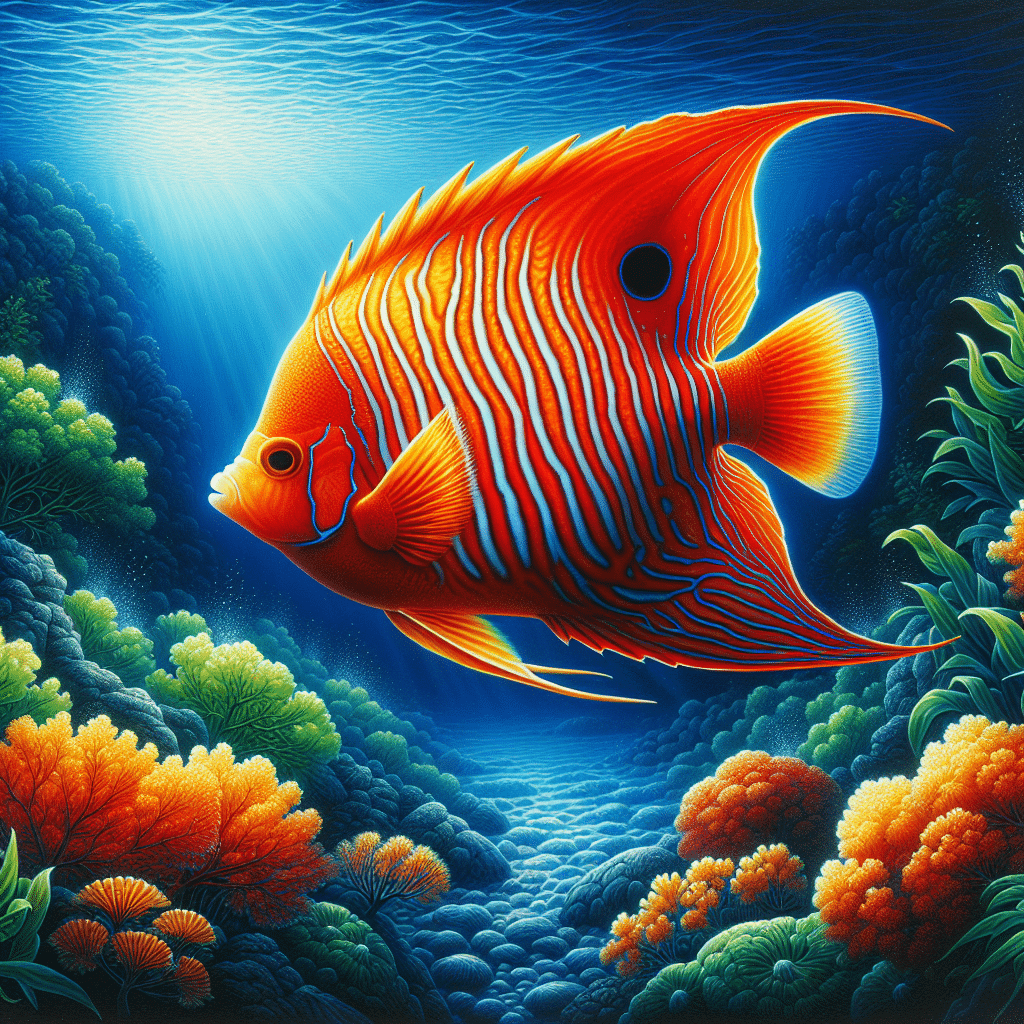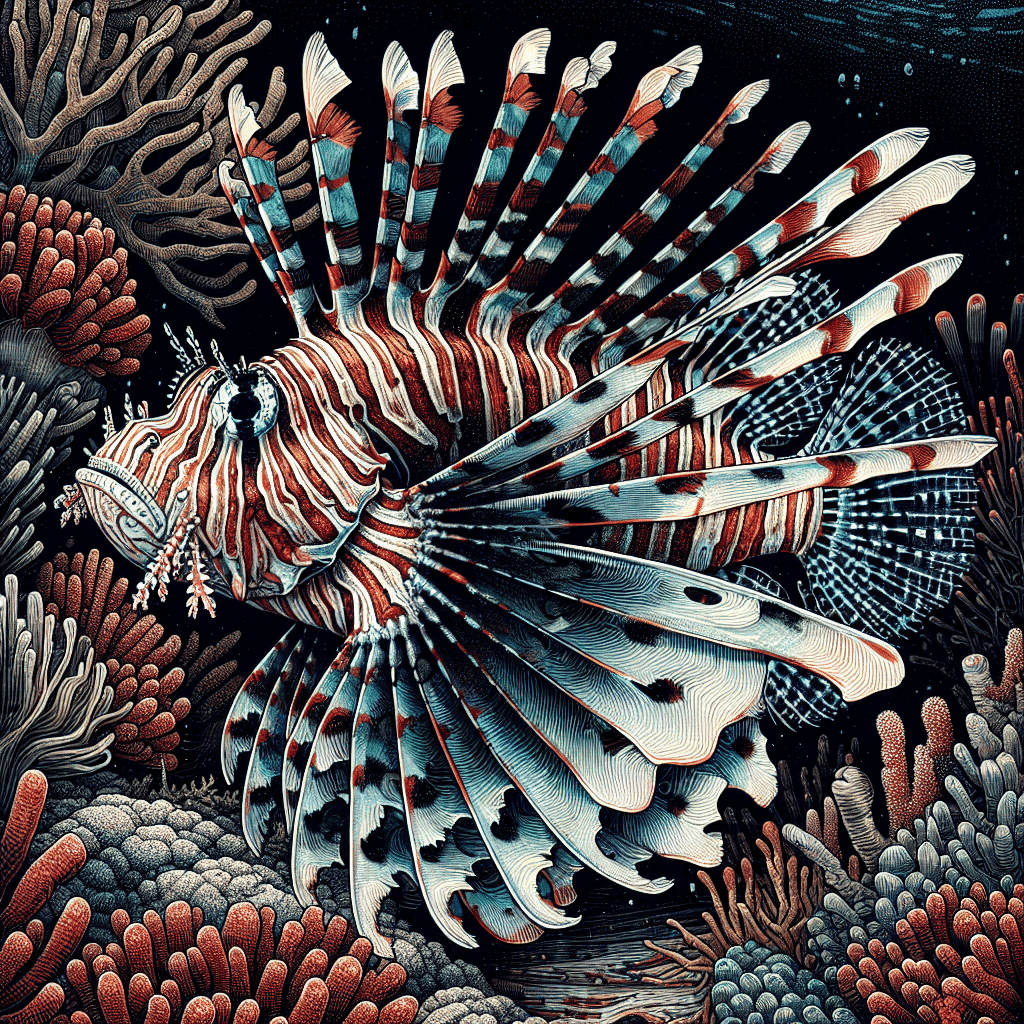Flame Angelfish Overview
Physical Characteristics
The Flame Angelfish (Centropyge loriculus) is a stunning dwarf angelfish known for its vibrant coloration. It typically grows up to 4 inches in length, making it a manageable size for many home aquariums. The body of the Flame Angelfish is bright reddish-orange adorned with dark bars on the sides. Its dorsal and anal fins are beautifully striped with blue and black, adding to its striking appearance (Australian Museum).
| Characteristic | Description |
|---|---|
| Maximum Size | Up to 4 inches |
| Primary Color | Bright reddish-orange |
| Unique Features | Dark bars on the body, blue and black striped fins |
Natural Habitat
Flame Angelfish are predominantly found in coral reefs and inshore areas within tropical regions of the western to central Pacific. Their distribution includes various reef ecosystems, such as the Marshall Islands, Line Islands, Cook Islands, Hawaii, and parts of the Great Barrier Reef in Australia (Australian Museum, MarineWise). These colorful fish thrive in well-maintained saltwater environments, requiring ample live rock for grazing and hiding.
For anyone interested in the care of Flame Angelfish, maintaining a suitable tank setup is essential. They are moderately challenging to keep and benefit from a varied diet that includes algae, brine shrimp, mysis shrimp, and high-quality marine angelfish preparations.
Flame Angelfish Care
Taking care of Flame Angelfish can be a rewarding experience. They are beautiful creatures that add vibrancy to any reef tank. Here’s what I’ve learned about their tank requirements, feeding guidelines, and health considerations.
Tank Requirements
Flame Angelfish thrive in a well-maintained saltwater environment. Here are the ideal conditions for their habitat:
| Requirement | Ideal Value |
|---|---|
| Minimum Tank Size | 50 liters (13 gallons) |
| Temperature | 24°C to 28°C (75°F to 82°F) |
| pH Level | 8.1 to 8.4 |
| Salinity | 1.020 to 1.025 |
A well-established tank with plenty of live rock is essential. Live rock provides grazing surfaces and hiding spots, which are crucial for their well-being. I find that maintaining stable water conditions is vital for Flame Angelfish, so I invest in a quality filtration system and perform regular water changes. For more information on marine fish care, you can check out our article on marine fish.
Feeding Guidelines
Feeding Flame Angelfish is straightforward but requires attention to variety. They are omnivores and benefit from a mixed diet. I typically feed them:
- High-quality marine angelfish flakes or pellets
- Frozen or live foods like brine shrimp and mysis shrimp
- Finely chopped seafood
Feeding should occur 2-3 times daily in small amounts to avoid overfeeding and maintain water quality. It’s important to keep an eye on the portion sizes, as overfeeding can lead to poor water conditions. You can find more about the specific types of fish food in the section on feeding marine fish.
Health Considerations
Regular health checks are essential for Flame Angelfish. Some common health issues include:
- White Spot Disease (Ich)
- Fin rot
- Velvet Disease
- Parasites
- Bacterial infections
- Swim bladder disease
Observing them for signs of illness is crucial. I make sure to maintain good water quality and provide a balanced diet to help prevent these conditions. If an issue does arise, prompt action is vital to ensure the health of my fish. For more tips on maintaining a healthy tank environment, you can explore our articles on specific fish like clownfish or triggerfish.
By following these care guidelines, I’ve had great success with my Flame Angelfish, and I hope you will too!
Flame Angelfish Behavior
Temperament
Flame Angelfish are known for their semi-aggressive nature. When first introduced to an established aquarium, smaller specimens may be shy. However, they quickly gain confidence and can often be seen grazing around live rock during the day. Their behavior is generally peaceful towards other fish but can become territorial, especially in smaller tanks. They are typically considered reef-safe, adapting well to a captive diet, which usually prevents them from consuming soft or stony corals. Instances of them picking at coral or clam mantles are often linked to being underfed or undernourished (Wikipedia).
| Behavior Characteristic | Description |
|---|---|
| Aggressiveness | Semi-aggressive, especially towards their kind |
| Feeding Habits | Grazes on algae and other food sources |
| Social Behavior | Initially shy but becomes more active as they acclimate |
Breeding in Captivity
Interestingly, Flame Angelfish have been known to spawn in captivity. Successfully bred specimens are offered by aquaculture facilities like Atoll Farm Aquaculture in Thailand. In the wild, they are haremic, meaning they can be kept in pairs or trios in an extra-large aquarium. The biggest challenge with breeding them lies in collecting the eggs and raising the larvae. They are broadcast spawners, releasing eggs and sperm simultaneously at dusk, rising into the water column to do so (Wikipedia).
| Breeding Characteristic | Description |
|---|---|
| Spawning Method | Broadcast spawners, releasing eggs at dusk |
| Breeding Environment | Can be kept in pairs or trios in large tanks |
| Challenges in Breeding | Collecting eggs and raising larvae |
Flame Angelfish can be a rewarding species to keep for both their vibrant colors and interesting behavior. They require careful monitoring and attention to ensure they thrive in a captive environment, so being informed about their temperament and breeding habits is essential for any enthusiast. If you’re interested in learning more about other marine fish, check out our articles on marine fish and various species that can complement your reef tank.
Flame Angelfish in the Wild
Diet in the Wild
The flame angelfish, known scientifically as Centropyge loriculus, has a varied diet in its natural habitat. It primarily feeds on algae and small crustaceans, which are abundant in the coral reefs and inshore areas it inhabits. In the wild, this diverse diet helps maintain their health and vibrant coloration. Here’s a quick look at what they munch on:
| Food Type | Description |
|---|---|
| Algae | Primary food source |
| Crustaceans | Includes small shrimp and similar organisms |
In captivity, I can replicate their natural diet with a variety of foods like brine shrimp, mysis shrimp, spirulina, seaweed sheets, pellets, and even some table shrimp. This variety is essential for keeping them healthy and happy.
Habitat and Distribution
Flame angelfish are typically found in tropical regions of the western to central Pacific. They inhabit coral reefs and inshore areas, which provide both shelter and a rich food supply. Their preference for these environments is crucial for their survival and well-being.
Here’s a breakdown of their habitat:
| Region | Characteristics |
|---|---|
| Western Pacific | Warm, tropical waters |
| Coral Reefs | Rich in biodiversity, providing shelter |
| Inshore Areas | Shallow waters where food is abundant |
If you’re curious about other marine species that share their habitat, you might enjoy learning about clownfish or parrotfish, both of which are essential members of the reef ecosystem.
Flame Angelfish in Captivity
Care Level and Tank Size
I find the flame angelfish to be a fantastic addition to my reef tank. They have a care level that ranges from easy to moderate, making them suitable for both novice and experienced aquarists. They are semi-aggressive, and while they are often considered reef-safe, caution should be exercised when introducing them to a tank with delicate corals. For optimal health, a minimum tank size of 70 gallons is recommended to ensure they have enough space to swim and establish territory (MarineWise).
Here’s a quick overview of the ideal tank conditions for flame angelfish:
| Parameter | Recommended Range |
|---|---|
| Temperature | 24°C to 28°C |
| pH Level | 8.1 to 8.4 |
| Salinity | 1.020 to 1.025 |
| Minimum Tank Size | 70 gallons (265 liters) |
These fish thrive in well-maintained saltwater tanks with plenty of live rock for grazing and hiding. I ensure that my tank is well-established, as this helps the flame angelfish adapt and flourish.
Breeding Challenges and Successes
Breeding flame angelfish in captivity can be a challenging yet rewarding experience. These fish are known for being moderately challenging to keep, and breeding them requires specific conditions. They are typically not bred in home aquariums, but if you’re keen to try, maintaining stable water quality and providing a varied diet is essential.
Flame angelfish do better in pairs or small groups, but I would recommend keeping only one male to avoid territorial disputes. The ideal environment would include plenty of hiding spots and a breeding area, which can be simulated using structures made from live rock.
Here’s a summary of the breeding considerations:
| Consideration | Details |
|---|---|
| Breeding Environment | Well-planted, with hiding spots |
| Pairing | One male with several females |
| Diet | Varied diet (algae, brine shrimp, mysis shrimp) |
| Water Quality | Stable with regular maintenance |
Though achieving successful breeding can be rare, I’ve heard of hobbyists who have managed to spawn them with the right care. If you’re interested in expanding your aquarium with flame angelfish, just remember to monitor their health and environment closely (Wikipedia).



